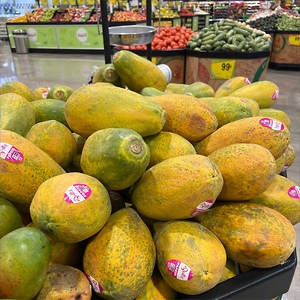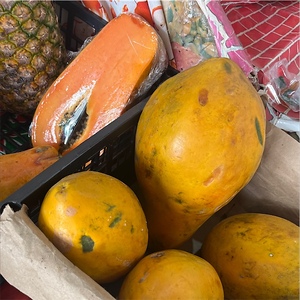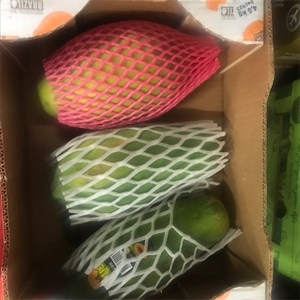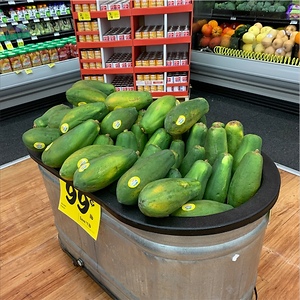

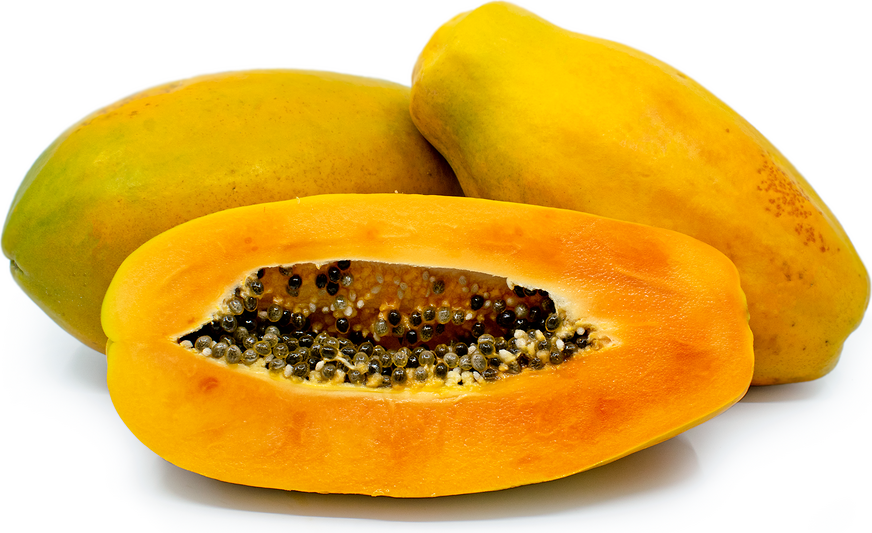
Mexican Papaya
Estimated Inventory, 35 lbs : 35.89
This item was last sold on : 04/23/25
Description/Taste
Mexican papayas are large fruits, averaging anywhere between 15 to 50 centimeters in length, depending on the variety, and have an oval to pyriform shape. The skin is thin, semi-smooth, and waxy, bearing variegated hues of bright yellow, orange, and pale green when ripe. Underneath the surface, the flesh ranges in color from red, orange, yellow to pink and has a soft, dense, and aqueous consistency. In the center of the flesh, there is also an elongated cavity filled with a thin layer of white fibrous tissue that encases many small, round, and shiny black seeds. The seeds are edible, containing a peppery, slightly bitter flavor, and have a crunchy, slippery texture as they are covered in a gelatinous coating. Mexican papayas have a mild, sweet, and musky flavor with tropical, fruity undertones.
Seasons/Availability
Mexican papayas are available year-round.
Current Facts
Mexican papayas, botanically classified as Carica papaya, are large, fragrant fruits native to tropical regions of Central America and Southern Mexico, belonging to the Caricaceae family. Papayas grow directly from the base of a large herb, just below the leaves, which is often incorrectly labeled as a tree. The fast-growing herb rivals the size of large trees, averaging three meters in height, and sometimes reaches up to nine meters in warm, humid climates. Mexican papayas are one of two main types of papayas found worldwide. The other is Hawaiian papayas. Within each type, there are many different varieties with varying appearances and flavors. Mexican papayas are much larger than Hawaiian papayas and generally have a milder flavor profile. The main Mexican papaya variety is known as the Maradol papaya, also found under the names Caribbean Red papaya, Caribbean Sunrise papaya, and Red papaya. Mexican papayas are favored for their soft, sweet flesh and are incorporated into a wide variety of fresh and cooked preparations worldwide.
Nutritional Value
Mexican papayas are an excellent source of vitamin C, an antioxidant that strengthens the immune system, reduces inflammation, and protects the cells against free radical damage. The fruits are also rich in calcium to protect bones and teeth, potassium to balance fluid levels within the body, vitamin A to maintain healthy organ functioning, and are a source of folate, fiber, iron, and magnesium. In addition to vitamins and minerals, Mexican papayas contain a beneficial enzyme known as papain that helps break down proteins for more efficient digestion.
Applications
Mexican papayas have a sweet, musky flavor and soft texture well-suited for fresh and cooked applications. The entire fruit is edible, including the skin, flesh, and seeds, but many consumers choose to discard the skin or eat the seeds separately for the sweetest flavor. It is also important to note that some fruits may contain a musky smell that can be neutralized with a squeeze of lime juice. Mexican papayas can be sliced in half, removing the seeds for later use, and filled with yogurt or cottage cheese as a breakfast dish. The flesh can also be sliced and mixed into fruit bowls, cut and tossed into salads, chopped into fresh salsas, blended into smoothies and fruit juices, sliced and cooked in quesadillas, pureed into sauces for roasted meats, or used as filling for cakes and pies. In addition to fresh preparations, Mexican papaya can be used as a flavoring for ice cream, sorbets, marmalades, and jams, or the pureed fruit can be used as a natural meat tenderizer due to its papain content. Beyond ripe flesh, green papayas have a firm consistency that is popularly shredded and used in salads or chutney, or the flesh can be sliced and simmered into curries, soups, and stews. The seeds are also edible and contain a peppery, slightly bitter flavor. The seeds are primarily consumed fresh, or they can be dried, ground into a powder, and used as a pepper substitute. Mexican papayas pair well with other fruits, including watermelon, strawberries, pineapples, coconut, bananas, and oranges, jicama, honey, brown sugar, cinnamon, ginger, chili powder, meats such as poultry, pork, and beef, and seafood. Whole Mexican papayas are ripened at room temperature. Once ripe, the fruits should be used immediately for the best quality and flavor and will keep up to three days when stored in a plastic bag in the refrigerator.
Ethnic/Cultural Info
Papayas were introduced to Asia through the Galeón de Manila, or the Manila Galleon, one of the first global trade routes that connected Asia to Europe. This route is also known as La Nao de la China, or the China Ships, and was operational between 1565 to 1815. The Manila Galleon route consisted of ports in China connecting to Manila, Philippines. From Manila, the ships would sail to Acapulco, Mexico, and connect to Veracruz and finally Seville, Spain. The trade route was the longest journey by sea during this era, spanning 15,000 miles, and one way of the trip took approximately 4 to 5 months. Ships traveling from Asia to Mexico would mainly carry luxury fabrics, swords, spices, and people, and ships traveling from Mexico to Asia would bring silver, cattle, and crops such as peppers, papaya, tobacco, and corn. Once papaya was introduced to the Philippines, it was widely planted and naturalized in the country’s warm, tropical climate. In the modern-day, papaya is a staple ingredient in both fresh and cooked applications throughout the Philippines. The most popular dishes include ensaladang papaya, or papaya salad, eating the fruits fresh, atchara, a crunchy side dish of unripe papaya pickled and mixed with ginger, peppers, onions, and garlic, or the unripe fruits are combined into filling for snacks such as lumpia. In addition to everyday applications, papayas are incorporated into dishes during the Dia del Galeón, a celebration held on October 8th in the Philippines to commemorate the Manilla Galleon trade route. This holiday marks the arrival of the first ship from the Philippines to Acapulco and was established to educate Filipinos of the historical importance that the route had on connecting global trade.
Geography/History
Papayas are native to Southern Mexico and Central America and have been growing wild since ancient times. The tropical fruits were later spread to South America, the Caribbean, the Bahamas, and Bermuda in the early ages. Once the Spaniards arrived in the New World, they transported papaya seeds to the Philippines in the 16th century, where the fruits were widely planted across the island and were later introduced into Malaysia, Indonesia, India, and other regions of Southeast Asia. Today Mexican papayas can be found growing in tropical climates worldwide and are cultivated for domestic use and international export. Papayas have also been naturalized in Central America, South America, the Caribbean, tropical Africa, Australia, Southeast Asia, and Asia and are found growing wild or cultivated as a home garden plant.
Featured Restaurants
Restaurants currently purchasing this product as an ingredient for their menu.
| Royal Polaris Sportfishing | San Diego CA | 619-226-8030 |
| Coral Del Mar | Del Mar CA | 858-449-6679 |
| Living Coast Discovery Center | Chula Vista CA | 619-409-5900 |
| Encontro North Park | San Diego CA | 310-955-6333 |
| Olivewood Gardens and Learning Center | National City CA | 619-434-4281 |
| The Santaluz Club Inc - Banquet | San Diego CA | 858-759-3150 |
| Dot Cafe | San Diego CA | 914-263-1424 |
| Nectarine Grove | Encinitas CA | 760-944-4525 |
| Miguel's Old Town | San Diego CA | 619-298-9840 |
| La Jolla Beach & Tennis Club | San Diego CA | 619-816-8319 |
| Reata Glen | Ladera Ranch CA | 949-545-2250 |
| The Monsaraz | San Diego CA | 858-760-6228 |
| US Grant Hotel Main | San Diego CA | 619-232-3121 |
| Candor | La Jolla CA | 858-581-2205 |
| Parkhouse Eatery | San Diego CA | 619 295 7275 |
| Madison | San Diego CA | 619-822-3465 |
| Tribute Pizza | San Diego CA | 858-220-0030 |
| Parisien Gourmandises | La Jolla CA | 858-352-6552 |
| Bread & Cie Café | San Diego CA | 619-683-9322 |
| Miguel's Cocina Carlsbad | Carlsbad CA | 760-759-1843 |
| Zanzibar at the Loft | La Jolla CA | 858-210-5476 |
| Tom Hams Light House | San Diego CA | 619-291-9110 |
| Hyatt La Jolla | San Diego CA | 858-552-1234 |
| Hasta Manana Cantina | San Diego CA | 619-276-6700 |
| Pamplemousse Grill | Solana Beach CA | 858-792-9090 |
| Wormwood | San Diego CA | 619-573-0289 |
| La Jolla Country Club | San Diego CA | 858-454-9601 |
| Cody's La Jolla | La Jolla CA | 858-459-0040 |
| Miguel's Cocina Pt Loma | San Diego CA | 619-224-2401 |
Recipe Ideas
Recipes that include Mexican Papaya. One
| Mexico In My Kitchen |
|
Papaya Drink |
| Skinnytaste |
|
Papaya Avocado Salad |



